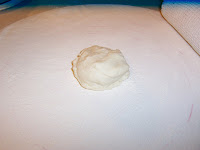Lori is different than many of the nurses in the critical care unit. She talks to me. And she uses words I understand. She tells me she has worked as a flight nurse in Detroit and that she’s been a nurse since the Florence Nightingale days.
Mom’s head is wrapped in a turban of gauze and tape. Her brain is so swollen that her right eye is bulging, like someone punched her. Intubated and on a ventilator, her tongue is bloody, crusty, swollen, and sticking out of her mouth beneath the endotracheal tube. Her chest heaves and a muffled, junky cough comes out through the ventilator, triggering an eerie, honking alarm.
We are hopeful. Last night Mom put her right hand up to her mouth and touched her breathing tube. Throughout the day, she wiggled her toes and fingers on her right side to command: thumbs up, thumbs down, and a wiggle of her pinky. Purposeful movements.
But now it is just before 4 am and her blood pressure is erratic. Alarms are sounding. She’s terribly congested. Her temperature is almost 102. Lori puts ice bags and a cooling blanket on her.
“Let’s just see what the next hour brings and then go from there,” Lori says. “This is the way it is with neuro patients. It’s like walking a fine wire fence. They could go either direction at any time. All we can do is read the symptoms and treat each one.”
We go through each night like this, walking the fine wire fence. Wiggle your toes. Squeeze my hand. We read to her, paint her toenails, and play her CDs. I realize that we have the same ridges in our fingernails, and that my toes are exactly like hers in their size and shape.
The noises haunt me. The whistling compression of air as the Venaflow sleeve contracts on her right leg, preventing the formation of blood clots. The beeps and clicks and alarms on the IVs and on the monitor that measures intercranial pressure. So many alarms.
For 13 days she walks that fine wire fence, the mysteries and miracles of critical care unfolding each moment. Medications support her blood pressure and for a while she doesn’t breathe above the rate on the ventilator. We watch fearfully as her intercranial pressure increases. Her heart rate and temperature are persistently high. She receives antibiotics for pneumonia. CT scans check for bleeding and swelling in the brain. A feeding tube is placed and so is a peripherally inserted central catheter (PICC line) for drawing blood and administering medicine arterially. She has high blood sugars so she is on an insulin drip. Her raw and scabby fingers are poked often to test her blood sugars. Her blood is drawn frequently to monitor delicate levels.
We have lost our center. On good days, we are giddy with hope. On other days, we cry and wander and try to prop each other up. We are in the embrace of friends, family, co-workers, and hospital staff who bring us meals, cards, flowers, and prayers. We are disoriented. We lose things—our vehicles, our coats, our minds. We are relieved to find Mom’s wedding ring at home. And life goes on. There are bills to pay, plants to water, pets to feed. We have divided Mom’s life among us, and still we cannot keep up.
One night, a family is standing around the bed of a new patient in the critical care unit. All the lights are on in the room. Moments later, an alarm sounds.
“Code blue, CCU…Code blue, CCU…” a computerized female voice repeats.
A woman screams. Footsteps pound down the hallway. “NO!!!!” the woman sobs.
More footsteps pound down the hallway.
In the middle of the night, I linger alone at Mom’s bedside, in this world of machines and monitors, where the sound of grief is profoundly louder than the combined chorus of many alarms. Where strangers don’t introduce themselves, bringing machines they don’t explain. I am terrified of the code blue. Terrified that we’ll have to bury our mother.








































